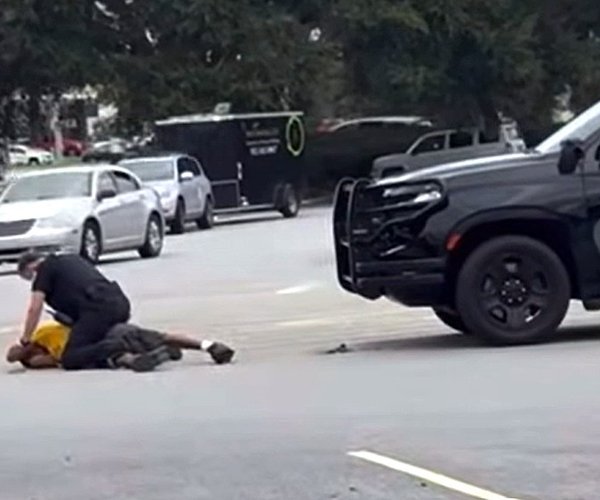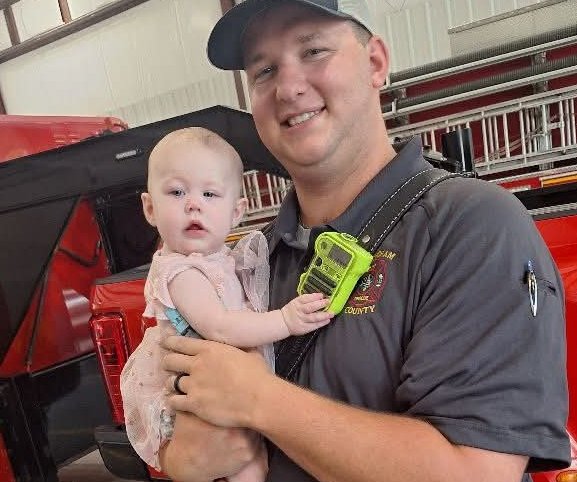FORT STEWART—Time heals all wounds, the saying goes. Still, after 25 years, the loss of comrades-in-arms was felt as the name of each of the 16 members of the 24thInfantry Division killed during Operation Desert Shield and Desert Storm was read aloud Friday morning in front of Fort Stewart’s Desert Storm Memorial.
But the dozens of 24thInfantry Division members, some still on active duty and others, clad once again in the “chocolate chip” desert camouflage uniforms, also were there to celebrate and relive the memories of 100 hours of swift, decisive destruction of their Iraqi foes.
“The emotions never go away,” said Gen. (ret.) Barry McCaffrey, who led the 24thon its deployment to Saudi Arabia and subsequent attack into Iraq. “I lost my brother-in-law in Vietnam and 28 of my West Point classmates. And we lost these 16 great soldiers. You don’t heal; mothers don’t forget their sons and daughters lost in combat.”
McCaffrey, one of the Army’s most highly-decorated soldiers, also paid tribute to the 26,000 soldiers under his command 25 years ago.
“I thought it would be two weeks to eight weeks and that we would win without any question,” McCaffrey said. “I thought at the time the 24thInfantry Division would have a couple thousand killed and wounded. So I thank God for the outcome.”
Iraq invaded Kuwait on Aug. 2, 1990, and five days later, the 24thInfantry Division, many of its soldiers recently returned from the National Training Center in the desert of Fort Irwin, Calif., was put on alert. Within a few hours, the first of 10 cargo ships left the port of Savannah headed for Saudi Arabia, loaded with 24thID equipment and vehicles.
By Sept. 12, the vast of the 24th’smen and material were in southwest Asia.
For weeks, the division trained and prepared for a coming ground assault against Iraq’s Republican Guard, the best-equipped and best-trained units under dictator Saddam Hussein. After 38 days of a nonstop aerial campaign, the 24thgot its orders from former division commander and leader of the multinational force of more than 900,000 troops, Gen. Norman Schwarzkopf. McCaffrey led 34 battalions, with 241 M1 Abrams tanks, 221 Bradley fighting vehicles and more than 7,800 other vehicles on their mission to block the Euphrates River valley as a means of escape and crash eastward into the Republican Guard divisions.
In 100 hours, the 24thcharged 260 miles into Iraq. The division’s advance elements were only 30 miles from the port city of Basra when the cease fire was called. Along with capturing two Iraqi airfields, and shooting up a number of enemy aircraft, the 24thdestroyed 360 Iraqi tanks and armored personnel carriers, 1,200 trucks, 19 missiles and took 5,000 prisoners of war.
The thousands of casualties McCaffrey feared numbered less than 150 for the nearly seven U.S. Army and two Marine divisions that thundered across the border.
The cost of war
Catherine Alaniz-Simonds was six months pregnant with the only child one of those soldiers, Spec. Andy Alaniz, would father, a child he never met. Alaniz, a member of the 24th’s 3/15 Infantry Battalion, was killed as the combat neared its end. Alaniz was a victim of friendly fire from another 24thID unit.
“I was in Oklahoma having a baby shower when I got call from my husband’s “cousin who said, ‘guess what? The guys are coming home,’” Alaniz-Simonds said. “Little did I know that a week later I would be greeting my husband’s casket at the Corpus Christi airport.”
She vowed her unborn baby would be named Andy. What they thought was going to be a boy was instead a girl. Her name is still Andy.
Alaniz-Simonds’ father Claude Arthur Medearis was killed when the Murrah Federal Building in Oklahoma City was blown up. Terry Nichols and Timothy McVeigh were eventually arrested and executed for the destruction and deaths resulting from the Oklahoma City bombing.
“It was very devastating,” Alaniz-Simonds said, “but I quickly learned that God’s loving grace is sustained and His plan is greater than my own. The loss of Andy helped me get my mother through her loss. I also learned that forgiveness is very powerful.”
The guests for the Desert Storm anniversary and memorial included renowned journalist and author Joe Galloway, who wrote “We Were Soldiers Once … and Young,” the account of the 7thCavalry’s battle with North Vietnamese forces in the Ia Drang Valley. It’s a book McCaffrey gives to elected and political leaders, emphasizing they pay close attention to the last two chapters. It’s there that Galloway chronicles how cab drivers roamed around Columbus and Fort Benning, delivering telegrams expressing the nation’s condolences to the next of kin on the loss of a soldier in southeast Asia.
Alaniz-Simonds said she has never blamed the fellow unit of the 24thfor her first husband’s death.
“And to this day, I still don’t,” she said. “There are a lot of guys who are having trouble 25 years later. The thought of Nichols and McVeigh’s names made my blood boil. When I witnessed McVeigh’s execution, it was like God spoke to me and said it was time to move on. Once I forgave McVeigh and Nichols, it’s like the weight of the world was lifted off my shoulders. As long as I held on to that hate and that anger, it’s like I allowed them to kill my dad every single day.
“My advice is be forgiving, be loving and remember. As long as we remember those who died, their life will never be forgotten.”
Lessons learned and objectives achieved
The U.S. was one of 39 countries in the coalition aligned against Iraq’s invasion of Kuwait. Like McCaffrey, Schwarzkopf and Gen. Colin Powell, many of the senior officers and noncommissioned officers in the Army at the time were Vietnam veterans.
“Most had been wounded,” said McCaffrey, who received two Distinguished Service Crosses for his combat actions in Vietnam. “We were bound and determined we weren’t going to let happen to this generation what happened to us. I think that paid off.”
The vast coalition, which included troops from Egypt, Syria and Qatar, poised to eject Hussein’s army from Kuwait, was a result of President George H.W. Bush’s efforts, McCaffrey said. President Bush visited the 24thin the Saudi desert for Thanksgiving in 1990, recalling how he spent Thanksgiving 1944 flying his fifth-to-last mission off the USS San Jacinto in support of the 24thInfantry Division’s advance in the Philippines.
Against Iraq, the U.S. had overwhelming force — more than 540,000 American soldiers and marines and a division each from the French and British armies — and a clear objective, McCaffrey said.
“We had a great president who understood he had to achieve his political purpose,” McCaffrey said. “We had wonderful generals, Gen. Colin Powell and Gen. Norman Schwarzkopf. We allowed the armed forces to do their job and achieve the objectives and come home. Because of it, we had comparatively low losses. Thank God we weren’t forced to kill many Iraqi soldiers either because we used overwhelming power. That’s a lesson going forward.”
As McCaffrey addressed the audience, the commanding general of Fort Stewart’s home unit, Maj. Gen. James Rainey, was just returning from a rotation to Afghanistan. McCaffrey noted how he and the 24thhad weeks to prepare for their invasion — but the Army’s heavy rapid deployment division now at Stewart may not have such preparation time in the future.
“We left here and we were the best-trained tank-mech-artillery battalions on the face of the earth because of the National Training Center,” he said. “I think we were grateful for six months in Saudi Arabia for day-night hard work to get our systems working together. And that’s a lesson for the 3rdInfantry Division in the coming years — how do you stay ready to fight with 30 days’ notice or less?”
What also makes Fort Stewart and Hunter Army Airfield unique isn’t just the ability of the Army to send thousands of combat-ready troops across the globe quickly, according to McCaffrey. There’s also something about the Coastal Empire surrounding it.
“Fort Stewart and Hunter Army Airfield are the primary launch points to train U.S. Army combat units. It’s one of the few places we can train and use all of our systems,” he said. “And it is in my judgment the most supportive community for a military post. All of us love serving here. It is just a great place to be a soldier. A lot of the soldiers who were privates or second lieutenants came back to this post because they asked to.”
The bonds that cannot be broken
The return of the 24th’s Operation Desert Storm veterans was spearheaded by the men in its own ranks, who came back to Fort Stewart to commemorate their victory and to pay tribute to the soldiers who didn’t make it home.
“It’s all about those 16 names on the wall,” said Steven Harrington, a Wyoming native and one of the reunion organizers. “I can’t describe the feeling of all these guys coming together, having not seen each other in more than 20 years. There’s a lot of healing going on, and that’s a good thing.”
It’s those life-long bonds formed in shared duty and in combat 25 years earlier that were evident on a brisk south Georgia morning, squeezed in between the sprawling post’s library and post exchange.
“We study why American soldiers fight. They are patriots,” he said. “They are fighting for their families and the Constitution. But at the end of the day, they fight so they won’t let their buddies down. That’s what you see when you see this kind of gathering.”
Dozens of soldiers, particularly those in the old DCUs with the Taro Leaf patches on the right shoulders, signifying their status as a combat veteran of the 24th, asked McCaffrey to pose for pictures with them after the ceremony. Their former commander heartily obliged.
“It’s enormously moving 25 years later to see these great soldiers come back,” he said. “When we deployed out of Fort Stewart, Hunter Army Airfield and Fort Benning, some 20,000 of us, we went off to confront aggression. We achieved our mission and came home. Today, we wanted to reconnect and remembered the hundreds of soldiers killed or wounded during that campaign. It was a great day with great memories. “
For Harrington, the gathering was also a reminder of what the division accomplished in its hurried deployment to the Middle East and its quick victory to liberate Kuwait.
“Not a day that goes by that I’m not proud of what we did,” he said. “The 24thInfantry Division is one of the best divisions in the world and always will be. I’m proud to be a Taro Leaf.”








